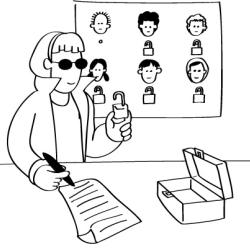Source Institutions
Source Institutions
Add to list Go to activity
Activity link broken? See if it's at the internet archive

In this activity, learners conduct a simulation exercise related to public key encryption and try to intercept a message sent between two learners. This activity works with two learners but is most exciting with a large group. Use this activity to introduce learners to cryptography, authentication, internet security/privacy issues and internet commerce. Background information and further reading suggestions are included in the PDF.
- Under 5 minutes
- 30 to 45 minutes
- free per group of students
- Ages 11 - 18
- Activity, Lesson/Lesson Plan, Simulation
- English
Quick Guide
Materials List (per group of students)
- two copies of the blackline master on page 193
- an overhead projector transparency of page 194
- a way to annotate the diagram
Subjects
-
Engineering and Technology
-
Computing
- Computer Science
- Information Systems
- Information Technology
-
Engineering
- Computer Engineering
-
Technology
- Information and Communication
-
Computing
-
Mathematics
-
Data Analysis and Probability
- Data Analysis
- Data Representation
-
Number and Operations
- Number Systems
- Reasoning and Proof
- Representation
-
Data Analysis and Probability
-
The Nature of Technology
-
Technology and Society
- Impacts of Technology
-
Technology and Society
-
The Nature of Science
-
Science and Society
- Risks and Benefits
- Ethics
-
Science and Society
Informal Categories
- Computers
Audience
To use this activity, learners need to:
- see
- read
- touch
Learning styles supported:
- Involves teamwork and communication skills
- Involves hands-on or lab activities
Other
Foreign language versions of this resource:
Components that are part of this resource:
Includes alignment to state and/or national standards:
This resource is part of:
Access Rights:
- Free access
By:
- Bell, Tim ; Witten, Ian ; Fellows, Mike
Rights:
- Creative Commons: Non-commercial No Derivatives (by-nc-nd), Computer Science Unplugged, 1998
Funding Sources:
- Brian Mason Scientific and Technical Trust
- Google Inc.
